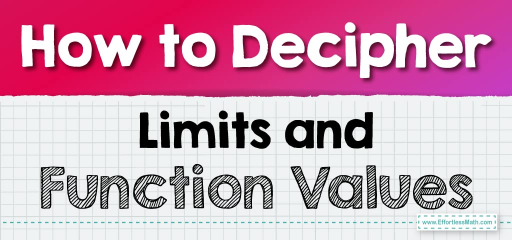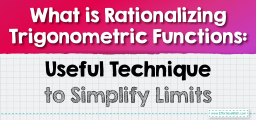How to Decipher Limits and Function Values
In the intricate tapestry of calculus and mathematical analysis, the concept of limits stands as a cornerstone. This guide serves as a beacon, casting light upon the sometimes shadowy relationship between limits and function values, guiding readers through their complexities with finesse and precision.

Step-by-step Guide to Understanding Limits and Function Values
Here is a step-by-step guide to understanding limits and function values:
Step 1: Grasping the Essence of Limits
Premise: The limit is a concept that captures the behavior of a function as its input approaches a certain value, but perhaps never actually reaches it.
Step-by-Step:
- Preliminary Exploration: Begin by visualizing the function using a graph. This aids in forming an intuitive understanding of its behavior near the point of interest.
- Approaching from Both Sides: Consider the function’s behavior as the input approaches the point of interest:
- From values less than the point (left-hand limit).
- From values greater than the point (right-hand limit).
- Equality of Approach:
- If the left-hand limit and the right-hand limit are equal and finite, then the limit at that point exists and is equal to that common value.
- Otherwise, the limit does not exist.
- Special Scenarios: Beware of indeterminate forms (e.g., \(0/0\) or \(∞/∞\)). Techniques like factoring, rationalizing, or L’Hopital’s rule may be employed to resolve them.
Step 2: Navigating the Nuances of Function Values
Premise: The function value captures the output of the function at an exact input value.
Step-by-Step:
- Direct Substitution: Initially, try plugging the point of interest into the function. This might immediately yield the function value.
- Encounter with Discontinuities: If direct substitution leads to undefined forms, the function might be discontinuous at that point.
- Tip: Look for holes, jumps, or asymptotic behaviors in the graph.
- Piecewise Functions: For functions defined differently over various intervals, ensure you’re using the correct formula for the interval that contains your point of interest.
- Functional Exploration: Sometimes, functions may be implicitly defined, or given in a form that’s not straightforward. Techniques like implicit differentiation or algebraic manipulation can help unearth the hidden function values.
Step 3: Bridging Limits and Function Values
- The Connection: A function is continuous at a point if the limit at that point exists and is equal to the function’s value at that point.
- Points of Discontinuity: Even if a limit exists at a point, it doesn’t guarantee the function’s continuity there. If the function value differs from the limit or is undefined, you’ve found a point of discontinuity.
Final Word:
Venturing through the realms of limits and function values can be akin to navigating a dense forest; while challenges abound, the rewards of understanding are unparalleled. Equipped with this guide, may your journey be filled with moments of eureka and enlightenment in the intricate world of mathematical functions.
Related to This Article
More math articles
- Estimating and Rounding
- How to Use Partial Products to Multiply Two-Digit Numbers By Two-digit Numbers
- How to Prepare for the OAR Math Test?
- 5th Grade RISE Math Worksheets: FREE & Printable
- How to Motivate Anyone to Start Learning Algebra and Geometry
- How to Select Procedures for Determining Limits?
- The Ultimate Regents Algebra 1 Course (+FREE Worksheets)
- How to Match Word Problems with the One-Step Equations?
- How to Find the Reciprocal Trigonometric Functions?
- How to Know the Difference Between Correlation and Causation


























What people say about "How to Decipher Limits and Function Values - Effortless Math: We Help Students Learn to LOVE Mathematics"?
No one replied yet.